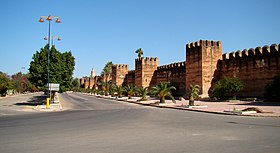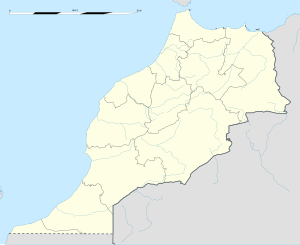Taroudant
|
Taroudant Tarudant / Rudana |
|
|---|---|

Taroudant's defensive wall
|
|
| Location in Morocco | |
| Coordinates: 30°28′15.59″N 8°52′50.16″W / 30.4709972°N 8.8806000°W | |
| Country |
|
| Region | Souss-Massa |
| Province | Taroudant |
| Elevation | 238 m (781 ft) |
| Population (2004) | |
| • Total | 63,000 |
| Time zone | WET (UTC+0) |
| • Summer (DST) | WEST (UTC+1) |
| Postal code | 83000 |
Taroudant (Berber: Tarudant, ⵜⴰⵔⵓⴷⴰⵏⵜ; Arabic: تارودانت) is a city in the Sous Valley in southern Morocco. It is situated east of Agadir on the road to Ouarzazate and the Sahara desert and south of Marrakesh. The town is known as the "Grandmother of Marrakesh" because it looks like a smaller Marrakesh with its surrounding ramparts. In the sixteenth century, the Saadians briefly used Taroudant as a capital before they moved onwards to Marrakesh. Today, the city has the feel of a small fortified market town on a caravan route.
Taroudant is known for its local crafts, including jewellery and carpets.
Unlike Marrakesh, almost the entire city of Taroudant is located inside its walls. A new part of the city is being developed outside the city walls around the campus of a faculty of the Ibn Zohr University of Agadir.
The town was occupied by the Almoravids in 1056.
Under the Saadi Dynasty Taroudant had its golden age, particularly under the reign of Mohammed ash-Sheikh. He constructed the city walls and built the great mosque and its minaret in 1528. The town became the capital of the Saadians who used it as a base to attack the Portuguese in Agadir. Although they later made Marrakesh their capital, they made the town prosper through the riches of the Sous plain, marketing goods such as sugar cane, cotton, rice and indigo.
...
Wikipedia

